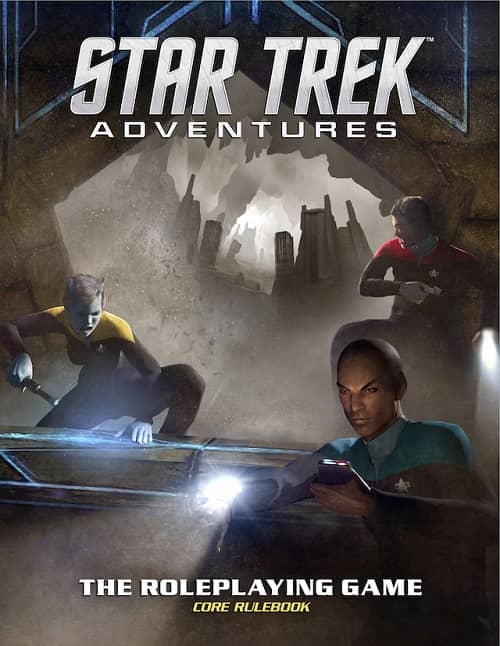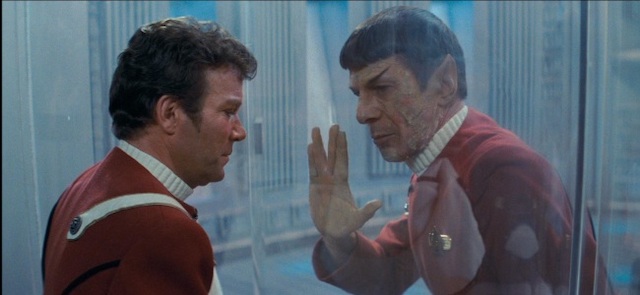The Continuing Mission: Star Trek Adventures
Star Trek has been a revered franchise for decades, and the FASA Star Trek RPG released in the 1980s is a oft cited classic game. The current RPG, Star Trek Adventures, is published by Modiphius. Supported by multiple supplements, adventures, and a forthcoming Klingon core rulebook, Star Trek Adventures is a compelling RPG that will let you live out your own Star Trek stories, regardless of era.
The game is oriented toward The Next Generation era of Star Trek, but the rules allow and often speak specifically to running games in the Original Series and Enterprise eras (Deep Space Nine and Voyager fall within The Next Generation era). Even the Kelvin timeline (i.e., the new film series with Chris Pine as Captain Kirk). Modiphius does not have the license rights to the newer Discovery, Picard, or Lower Decks series showing on CBS All Access, but adapting the game to suit those settings is readily done.
Players can create characters who are Human, Vulcan, Andorian, Bajoran, Betazoid, Denobulan, Trill, and Tellarite — or even a hybrid of two. Many additional species are available in supplements. Characters have six attributes that measure innate qualities: Control, Daring, Fitness, Insight, Presence, and Reason. These are used in conjunction with the Disciplines: Command, Engineering, Conn (this is piloting), Science, Medicine, and Security. These relate to the specializations in Starfleet, for the players are presumed to be Starfleet personnel.
For many RPG players, they will find the lack of a list of “skills” odd. Star Trek Adventures allows for Focuses, which are often equivalent to skills. However, these can be, frankly, anything. A player may designate Phasers as a focus or the Scientist might choose Xenoarchealogy. Another might choose Transporters. The options are boundless. This makes sense from a mechanical standpoint, however, for the rolls use Focuses in terms of results. What does that mean?
First, when making a roll, a player or the game master (GM) chooses the Attribute and Discipline they use. Are you trying to make a tricky but careful docking maneuver with that derelict ship? That’s Control plus Conn. Trying to make a quick maneuver to avoid that Romulan Warbird de-cloaking? Control plus Daring. Grab two 20-sided dice and attempt to roll under the combined value of the Attribute plus Discipline. Each die that rolls under generates a Success.
Generally, you need one Success to succeed at the task — though more challenging tasks can require more. If a roll results in more Successes than are required to succeed, the extra Successes become Momentum, a pool of points available to the players for various uses. Importantly, if a Focus is applicable to a roll (i.e., if that avoiding the Warbird pilot also has a Focus of Evasive Maneuvers, then each Success rolled counts double — hence, likely generating more Momentum).
Momentum can be used in a variety of ways, one of the easiest being purchasing additional dice for the roll — helping to move the odds in favor or rolling more Successes. The first extra die purchased costs 1 Momentum. The second costs 2 Momentum. The third costs 3 Momentum and is the maximum that can be purchased (the total dice pool rolled cannot exceed 5 dice). Other options include adding an Advantage to a scene or removing a Complication. Essentially, these two items are polar opposites and represent narrative devices that help improve the odds of success or make the task more difficult — or create future opportunities or potential consequences. Players can instead spend Momentum to create a problem for adversaries, which increases the difficulty of the task for every 2 Momentum spent. Players seeking information can also spend a Momentum point to ask the GM a single question relevant to the scene, which the GM must answer truthfully, though it does not need to be complete.
The Threat pool is the GM’s answer to Momentum. She can spend the pool just like players can spend Momentum. The GM starts a gaming session with 2 Threat per player. Certain character actions can generate more Threat that gets added to the pool. In general, the Threat pool is expected to increase and decrease during the session, with a general upward trend as the stakes and danger grow. As the norm with this type of game currency — pools that can both increase and decrease — using them in game is an important element. Hoarding them and never using them tends to diminish their value. That said, saving them up is also advantageous to use when critically important.
An interesting mechanic in Star Trek Adventures is the Values system. These are beliefs or deep-seeded motives that empower characters and give them a driving force forward. Spock’s “The needs of the many outweigh the needs of the few or the one” is such a value. A Klingon warrior’s honor before surrender is another. Players can use the Values in game via a second in-game currency called Determination. Each character begins each session with one point of Determination.
What does this point give you? You can use it to get an extra d20 for a roll — no need to spend Momentum. Or a player can use it to re-roll all the dice in their dice pool. Didn’t score the needed Success. Spend that Determination to let you re-roll it. The character could complete another task immediately after the end of another — particularly useful in structured time encounters — combat or time-based actions. And finally the player can create an immediate Advantage in a scene.
The key spending Determination is that the Value must be employed to spend that Determination. Perhaps the Klingon warrior is faced with a dire situation where surrender might be an option. Calling upon her reserves and facing the fact that honor is more important, she may spend that point of Determination. But perhaps the situation is warranted to surrender. The Klingon can then challenge her Value. In that case, the player gains a point of Determination and crosses that Value off, replacing it with another based on what caused the challenge in the first place — perhaps surrender meant the killing of thousands of innocents and she no longer see that honor overrides the deaths of innocents.
Star Trek Adventures includes rules for opposed tasks and extended tasks — i.e., ones that carry across time or require multiple checks. One of my favorite additions is the Scientific Method task. This seems like a perfect pairing of Star Trek’s love of technobabble and the incorporation of scientific investigation into the game — a centerpiece of many episodes. The task follows the scientific method: Observe, Hypothesize, and Test. This is also called a Gated Challenge and is useful in other contexts. The basic thrust of it is that during Observe, characters with the correct Engineering, Science, or Medicine disciplines roll their d20s. In most cases, this requires zero Successes — if rolled at all. At this time, the problem is classified as an engineering, scientific, or medical problem and one of the players is designated the Research Lead.
Moving to the Observe step, the Research Lead presents 3 to 5 hypotheses. If one of them fits with the GM’s intention, it is called the Right Way (though this is kept secret from the players). If none of them are correct, the GM increases her Threat pool by one, and the players go back to come up with more hypotheses. (The GM is, of course, able to decide on the fly if one of the player’s ideas is interesting enough to become the Right Way if not originally intended as such.)
For the Testing phase, the GM assigns a number of Successes that must be met — between 1 and 10. The Research Lead chooses a direction from the hypotheses. Players can switch between hypotheses. This becomes particularly relevant if a time-constraint is in place — figuring out the gaseous anomaly’s weak point in six rounds before it devours the Away team means that the players cannot test all the hypotheses. They will have to see how they are succeeding and determine if continuing on the path is prudent or if switching is wiser. The moment of breakthrough is when the number of Successes rolled in the Testing phase — presuming they are on the Right Path.
This is a nifty system. It allows for the way Star Trek often approached scientific elements — think of crew dealing with a heretofore unknown form of life discovered on a terraformed planet. Is it life? Can it communicate? How can we begin to understand this? The Scientific Method challenge is a way to bake that into the game with some mechanics. The GM does not even need to have a specific answer in mind, for she can leverage one of the player’s hypotheses as the right solution.
The system has a couple of other mechanics that work exceedingly well within a Star Trek campaign. The first is the use of additional crew members. The crew size of most starships in Star Trek far exceeds the number of players in a group. In general, this would mean that players and GM have a couple of possibilities. The first is to generate NPCs that the GM runs or allows the players to run. The other is that the players formally create additional characters for those roles their team does not cover. Neither way is particularly elegant or desired — though they may be fine for some gaming tables. Star Trek Adventures, however, formalizes the NPC route but with a bit more in the way of instruction: Supporting Characters.
Players create supporting characters in much the same way as their main character. However, supporting characters do not start with Values or Talents. They are waiting in the wings. Perhaps the gaming group lacks a dedicated Chief Engineer, so they create one for when she is needed or if the game brings that character to the fore of the story. When the supporting character is first introduced, the players choose to add a Value, increase a rank in a single Attribute or Discipline, add a Focus, or add a Talent. The GM still “owns” the supporting character, but she is available to the players should the need arise or the story dictates. This is particularly helpful for small crews or if one of the players plays the captain and wants to follow the more reasonable precaution of not joining the Away team for every dangerous mission. Instead of having to wait out the scenes involving the Away team, the player could pick up the appropriate supporting character and play her.
Star Trek Adventures also works hard and does a good job of making the ship a character in the story. The Enterprise is iconic, and many gaming groups want to experience that sense wonder and fun. Some gaming systems have detailed and involved starship construction methods (which I tend to like), but Star Trek Adventures eschews these for a simplified and satisfying approach. Players choose a “frame” — think of all the classes of Star Trek ships (the Enterprise of The Next Generation is a Galaxy-class ship, while that of the Original Series is a Constitution-class ship). This sets certain parameters about size, add-ons, and so on. The frame comes with basic ranks in Systems and Departments — the ship equivalent of Attributes and Disciplines. Starships also get Talents — things like Advanced Research Facilities or Emergency Medical Hologram. Finally, ships can contribute rolls to tasks as a way of assisting.
As an example, when Captain Zagus attempts to communicate with the seemingly hostile Cardassian ship, he finds the communications are not getting through due to the magnetic storm of a nearby nebula. He decides to have his Communications officer attempt the effort. The GM indicates that the officer can use her Reason attribute and Science discipline. Meanwhile, the ship rolls on its Comms system and Science department as well. Thus, the player rolls two dice to she if she succeeds and the ship rolls once and adds any success (or complication if a critical failure).
Star Trek Adventures further emphasizes its embracing of Star Trek by detailing rules for social conflict before combat, and the weapons list is quite short. Phasers of several types, melee weapons, and so on. While combat can and does happen, the writers of the rules put forward more Star Trek-ian flavor and orientation.
Overall, Star Trek Adventures is an excellent system with rich but simple mechanics that support the feel of a Star Trek game. Modiphius as done a superb job, and any wishing to play in the Star Trek universe should take a look at this game system. I look forward to my own gaming group’s continuing missions.
Patrick Kanouse encountered Traveller and Star Frontiers in the early 1980s, which he then subjected his brother to many games of. Outside of RPGs, he is a fiction writer, avid tabletop roleplaying game master, and new convert to war gaming. His last post for Black Gate was Understanding the New Order. You can follow him and his brother at Two Brothers Gaming as they play any number of RPGs. Twitter: @patrickkanouse. Facebook: Two Brothers Gaming












I like the books, and the adventures, the feel, the flavor, everything.
I can’t shake my dislike of 2D20 system, though. It just feels overcomplicated/using metagaming to drive the story, the somewhat antagonistic role it puts the GM in. I appreciate the idea of it all, but it just doesn’t feel necessary, it feels like drama should be solely just up to the GM to twist and modify things, rather than dice pools, etc.
Hello and thank you for reading and commenting! Folks definitely seem to either like or dislike the 2D20 system. From my personal experience, I haven’t yet seen it put me in an antagonistic role and allows me to be a bit more free to improvise (I tend to build a lot of background to help set the campaign with rough guides for the explicit sessions and then improv the rest–not unique, I’m sure) and accept that within the session. I’m come around to some metagaming–though I suspect in a few years time we’ll see metagaming go out of fashion. For me with Star Trek Adventures and 2D20–the Values system really is the core of the game–challenging or using the value to enable the player to drive narrative and grow.
But hey, that’s the way I like to play. Not liking the system for what you noted is perfectly valid. 🙂
For anyone with some d20 gaming experience, there’s no doubt that adapting to the 2d20 system takes some conscious effort. I haven’t bought in to it to the extent that fellow Black Gater Gabe Dybing has, but I can see merits.
It’s definitely an interesting system, it’s just having now GMd some Call of Cthulhu, I’m really appreciating a leaner system / running things largely on a narrative level. Dice rolls are definitely still there.
I think it’s worth considering whether what 2D20 does is even metagaming. I’ve never actually played ST:A, or a 2D20 game, I’ve just read the rules and an adventure and I loved a lot of it, but yeah, it is definitely coming at p&p from a different perspective from either more pure narrative RPGing vs. something like DnD and down into the crunchier side of things.